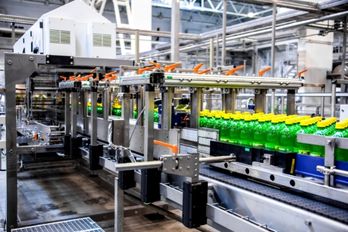
Creating clear, legible data comes from reliable equipment. Thermal inkjet printing and continuous inkjet printing are popular choices for making readable labeling for many surfaces. Metal, glass, plastic, and other material work well with inkjet printing projects.
But what is the difference between continuous inkjet printing and thermal inkjet printing? Let’s review their functionality, features, and considerable differences to determine which best suits your needs.
What Is Continuous Inkjet Printing?
How does a continuous inkjet printer work? It’s a machine that contains two liquids: one for the ink itself and one for a solvent. The two liquids feed into a larger tank, where it becomes a mixture that gets pressurized and fed into the printer head.
Once the pressurized mixture fills the printer head, piezoelectric elements create ink droplets through oscillation, propelling them toward the nozzle’s substrate. At the same time, electrical charges get delivered to the drops, guiding the ink toward the desired substrate. Meanwhile, non-charged drops get sent back to the main tanks.
What Is Thermal Inkjet Printing?
Thermal inkjet printers use disposable cartridge ink without needing an electrical charge. Instead, the machine heats the ink with resistors, resulting in vapor bubbles. It’s an effect that pushes liquid toward the nozzle tip and promotes a print drop to eject.
As the bubble collapses onto the substrate, it creates a vacuum and pulls more ink into the print head from the cartridge. The bubble itself is heated to 664 degrees Fahrenheit, or 340 degrees Celsius.
Continuous & Thermal Printing Differences
One significant difference between continuous and thermal inkjet printing is that thermal inkjet printing doesn’t need separate ink and solvent cartridges, nor does it require a maintenance contract. Continuous inkjet printers use two cartridges, ink and solvent, that circulate mixed, then travel to the piezoelectric elements to create streams of ink drops on various substrates.
Secondly, thermal inkjet printing is a simpler counterpart to continuous inkjet printing, and it’s able to create high-resolution labeling for expiration dates. It helps consumers recognize how long to keep products, ensuring less food waste and promoting food safety. Lastly, continuous inkjet printing generally requires an initial professional installation due to the more complex start-up process of the printers. While both types of printing provide solutions for industrial printing, continuous inkjet printers help tremendously with creating clear, precise labeling from a longer substrate distance than thermal printers.
Continuous and thermal printing can improve the quality and productivity of manufacturing businesses. At Factronics USA, we carry reliable inkjet printers that produce precise, legible data that consumers can understand. We provide thermal transfer printers that improve production line output at low ownership costs. If you want to know more about our user-friendly inkjet printers and laser coding products, we will help you get started today.
